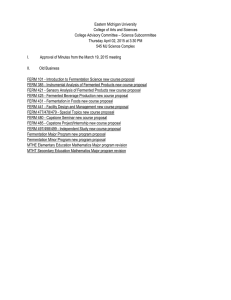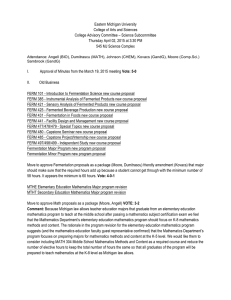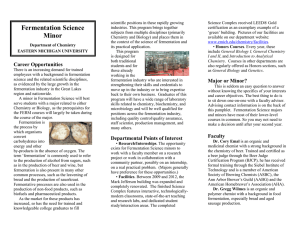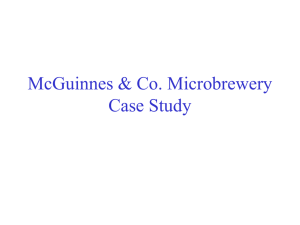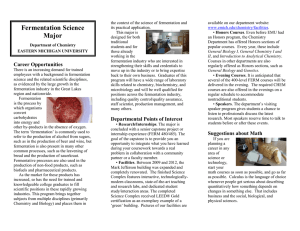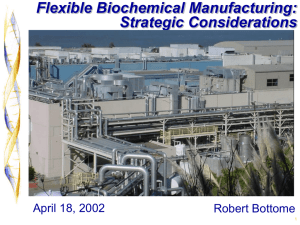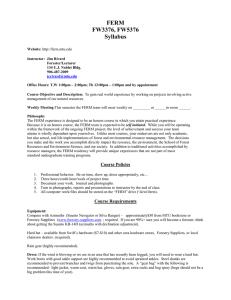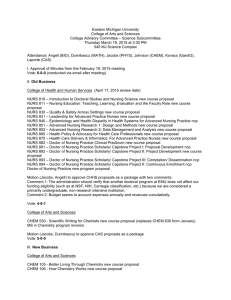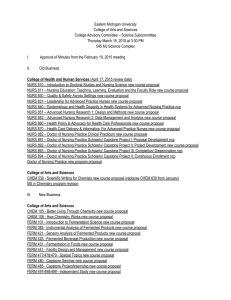O S P N
advertisement
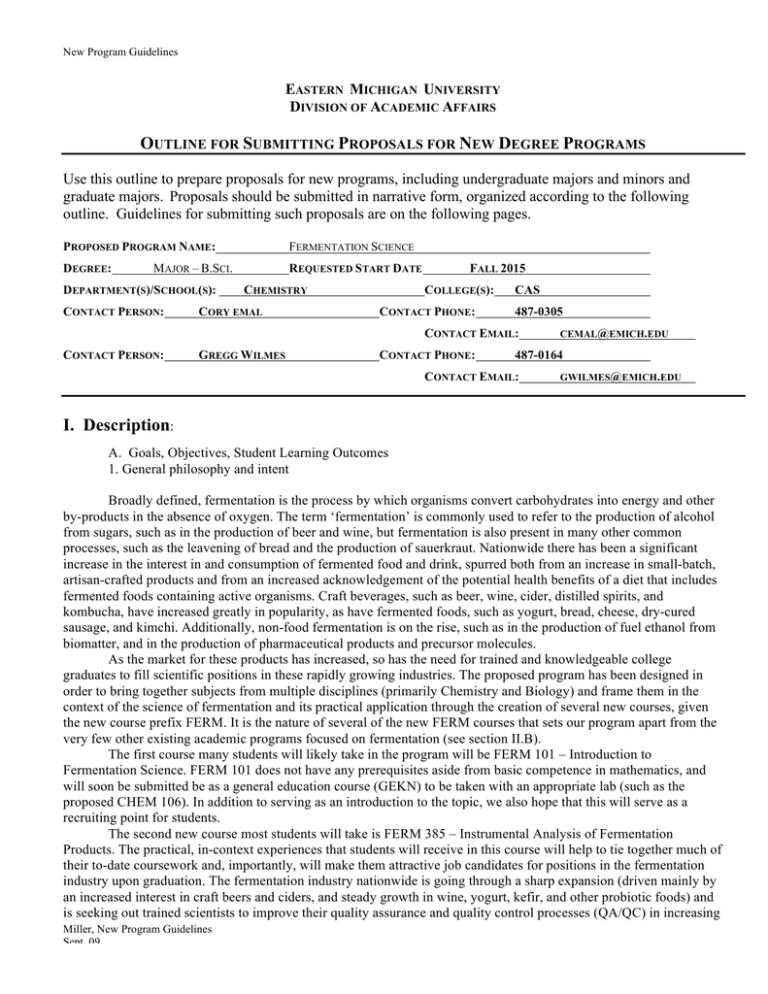
New Program Guidelines EASTERN MICHIGAN UNIVERSITY DIVISION OF ACADEMIC AFFAIRS OUTLINE FOR SUBMITTING PROPOSALS FOR NEW DEGREE PROGRAMS Use this outline to prepare proposals for new programs, including undergraduate majors and minors and graduate majors. Proposals should be submitted in narrative form, organized according to the following outline. Guidelines for submitting such proposals are on the following pages. PROPOSED PROGRAM NAME: FERMENTATION SCIENCE DEGREE: REQUESTED START DATE MAJOR – B.SCI. DEPARTMENT(S)/SCHOOL(S): CONTACT PERSON: CHEMISTRY CORY EMAL FALL 2015 COLLEGE(S): CONTACT PHONE: CAS 487-0305 CONTACT EMAIL: CONTACT PERSON: GREGG WILMES CONTACT PHONE: CEMAL@EMICH.EDU 487-0164 CONTACT EMAIL: GWILMES@EMICH.EDU I. Description: A. Goals, Objectives, Student Learning Outcomes 1. General philosophy and intent Broadly defined, fermentation is the process by which organisms convert carbohydrates into energy and other by-products in the absence of oxygen. The term ‘fermentation’ is commonly used to refer to the production of alcohol from sugars, such as in the production of beer and wine, but fermentation is also present in many other common processes, such as the leavening of bread and the production of sauerkraut. Nationwide there has been a significant increase in the interest in and consumption of fermented food and drink, spurred both from an increase in small-batch, artisan-crafted products and from an increased acknowledgement of the potential health benefits of a diet that includes fermented foods containing active organisms. Craft beverages, such as beer, wine, cider, distilled spirits, and kombucha, have increased greatly in popularity, as have fermented foods, such as yogurt, bread, cheese, dry-cured sausage, and kimchi. Additionally, non-food fermentation is on the rise, such as in the production of fuel ethanol from biomatter, and in the production of pharmaceutical products and precursor molecules. As the market for these products has increased, so has the need for trained and knowledgeable college graduates to fill scientific positions in these rapidly growing industries. The proposed program has been designed in order to bring together subjects from multiple disciplines (primarily Chemistry and Biology) and frame them in the context of the science of fermentation and its practical application through the creation of several new courses, given the new course prefix FERM. It is the nature of several of the new FERM courses that sets our program apart from the very few other existing academic programs focused on fermentation (see section II.B). The first course many students will likely take in the program will be FERM 101 – Introduction to Fermentation Science. FERM 101 does not have any prerequisites aside from basic competence in mathematics, and will soon be submitted be as a general education course (GEKN) to be taken with an appropriate lab (such as the proposed CHEM 106). In addition to serving as an introduction to the topic, we also hope that this will serve as a recruiting point for students. The second new course most students will take is FERM 385 – Instrumental Analysis of Fermentation Products. The practical, in-context experiences that students will receive in this course will help to tie together much of their to-date coursework and, importantly, will make them attractive job candidates for positions in the fermentation industry upon graduation. The fermentation industry nationwide is going through a sharp expansion (driven mainly by an increased interest in craft beers and ciders, and steady growth in wine, yogurt, kefir, and other probiotic foods) and is seeking out trained scientists to improve their quality assurance and quality control processes (QA/QC) in increasing Miller, New Program Guidelines Sept. 09 New Program Guidelines 2 numbers. In addition to being a keystone piece of the proposed program, we hope that this course will help to set our program’s graduates apart in the marketplace. A key component to the proposed program is its flexibility. Fermentation science is a broad and evolving field, and our students will have a variety of career goals. In recognition of this fact, a significant portion of the credits in the program are restricted electives, chosen from a set of new FERM courses and from existing courses across multiple colleges. Students will be required to elect six credit hours from a rotating group of FERM courses covering a variety of topics, including sensory analysis and tasting panel creation, fermented beverage production, fermented food production, and facility design and management. New courses can easily be created and added to the rotation, driven by student/faculty interest and available expertise; we hope to add courses focusing on industrial fermentation, yeast/microbe management, and others as the program grows and evolves. Additionally, students can elect further courses in chemistry and biology, or select appropriate courses related to the hospitality industry, marketing, accounting, etc., that support their interests and career goals. Finally, the program is concluded with a senior capstone project/internship experience (FERM 480/485). The goal of the capstone is to afford students an opportunity to use apply what they have learned throughout their coursework towards a real problem in collaboration with a community partner. This portion of the program has the possibility to have the greatest impact on all involved parties, building stronger ties among all involved: EMU (both our program and the university as a whole), our program’s external partners, and our students. Discussions with potential community partners have revealed a great enthusiasm for working with our students and strengthening these bonds. Importantly, we believe that this program will serve to attract students to EMU that might not otherwise consider us, or any other four-year college. Given that there is currently a paucity of academic programs directly and purposefully serving the burgeoning fermentation industry, EMU has the opportunity to quickly become a highly visible and attractive destination for students wishing to enhance their knowledge, abilities, and attractiveness to employers in this discipline. 2. Goals, objectives, and student learning goals Program goals: 1. To provide an integrated and practical educational experience for students interested in the science behind fermentation, including the production of fermented beverages, foods, and industrial products. 2. To afford the opportunity for students to have meaningful interactions and learning experiences with the local community, specifically those who are a part of the broadly defined fermentation industry. 3. To create an environment for students to develop broadly transferrable and applicable professional skills and an appreciation for scientific inquiry. Program learning outcomes and objectives: 1. Students will demonstrate knowledge of the chemistry, biology, and physics underpinning the process of fermentation and the production of fermented products. Components include: • Biochemical process of fermentation by yeast and bacteria (at laboratory and industrial scales) • Classes of biomolecules involved in fermentation and fermented products • Causes, identification, and prevention of defects • Sensory and instrumental analysis of fermented products 2. Students will demonstrate practical facility with various aspects of the fermentation industry. Components include: • Chemical and microbiological analysis of ingredients and fermented products • Sanitation and safety in laboratory and industrial settings • Planning and production of a commercial-grade fermented good • Business aspects (e.g. three-tier system, marketing, accounting, regulatory environment) 3. Students will demonstrate professional skills and standards. Components include: • Oral presentations • Laboratory notebooks Miller, New Program Guidelines Sept. 09 3 New Program Guidelines • • • Written reports Collaboration Ethical standards 4. Students will investigate a problem in the fermentation industry, formulate a path of inquiry, and carry out the investigation. Examples include: • Design and/or implementation of an analytical process • Development of a new recipe • Assess impact of change of conditions on an existing process 3. Alignment with departmental, college, and university goals The proposed program in Fermentation Science aligns well with department, college, and university goals and objectives. Per its mission statement, the Chemistry department intends to “prepare students for entering the workforce…by equipping them with a foundational knowledge of chemistry and an appreciation for scientific inquiry through mentoring and training in the classroom, laboratory, and community.” This program meshes well with this vision; students will be well prepared to enter the fermentation industry at a variety of positions, and will acquire this preparation through gaining field-specific knowledge in context with practical, hands-on projects and community experiences. The creation of this program supports multiple College of Arts and Sciences and University goals and objectives. • Community engagement and collaboration will be a significant feature of this program, as we will make and maintain mutually beneficial partnerships with many members of the local and regional fermentation industry. This supports Goal 3.2 (“Increase and promote community engagement activities”) and Goal 3.4.2 (“Strengthen student-alumni relationships”) in the CAS Strategic Plan, and Goals 1 and 2 of the University’s Service and Engagement strategic theme (“Enhance community partnerships with EMU” and “Improve community perceptions of EMU”, respectively). • The Fermentation Science program will be one of a very small number programs of its kind nationwide, providing a unique learning experience for our students and providing increased visibility of EMU regionally and nationally. This aligns with CAS Goal 4.2.1 (“Improve CAS Campus internal and external visibility”) and Goal 4.4 (“Improve CAS value and image to external communities”), and with Goal 1 of the University’s Student Engagement and Success strategic theme (“Create and expand purposeful learning communities inside and outside of classrooms, in the community, and globally”). • Our students’ increased training and experiences in this innovative new program will be fulfilling a regional and national marketplace need, and will reach a population of students that might not otherwise attend EMU. This aligns with Objectives 1.4 and 3.3 of the University’s High Performing Academic Programs strategic theme (“Create and support innovative academic programs and pedagogy” and “Create a framework for the development of new academics programs that meet community/regional and market needs”, respectively). B. Program 1. Courses included in the program: FERMENTATION SCIENCE MAJOR Required Courses (58-64 credit hours) FERM 101 (3) Intro to Fermentation Science FERM 385 (3) Analysis of Fermented Products FERM 480 (1) Capstone Seminar FERM 485 (2) Capstone Project/Internship Elect 6 credit hours from: FERM 421 (2) Sensory Analysis of Fermented Products Miller, New Program Guidelines Sept. 09 9 4 New Program Guidelines FERM 425 (2) Fermented Beverage Production FERM 431 (2) Fermentation in Foods FERM 441 (2) Facility Design and Management HRM 150 (2) Sanitation in the Hospitality Industry 6 MATH 120 (4) Calculus I or MATH 170 (3) 3-4 PHY 221 (4) Physics I 4 CHEM 121/122 (4) General Chemistry I with lab CHEM 123/124 (4) General Chemistry II with lab CHEM 270/271 (5) Survey of Organic Chemistry/Lab or 371/372/373 (8) Organic Chemistry I/II/Lab CHEM 281 (4) Analytical Chemistry CHEM 351 (4) or CHEM 451 (3) Biochemistry I 20-24 BIO 110/111 (5) General Biology I with lab BIO 301 (3) Genetics* BIO 305 (3) Cell and Molecular Biology BIO 425 (5) Microbiology 16 *Completion of BIO 110, or equivalent coursework, is required for fermentation science students to obtain biology departmental permission for 300- and 400-level biology courses. Choose one of: CHEM 453W (2) Biochemistry Lab BIO 306W (3) Cell and Molecular Biology and Genetics Lab 2-3 Electives: Take 12 credits from the following: Any FERM course not elected above (limit of 3 credit hours of Independent Study). CHEM 452 (3) Biochemistry II CHEM 453W (2) Biochemistry Lab (if not taken as required option) BIO 306W (3) Cell and Molecular Lab (if not taken as required option) HRM 103 (3) Introduction to the Hospitality Industry HRM 180 (3) Food Production HRM 251 (3) Meal Service Management HRM 340 (3) Cost Controls in the Hospitality Industry HRM 376 (3) Legal Aspects of the Hospitality Industry HRM 385 (3) Global Hospitality Management HRM 470 (3) Hospitality Industry Marketing HRM 485 (3) Beverage Management ACC 240 (3) Principles of Financial Accounting MET 314 (3) Applied Thermodynamics and Heat Transfer *Other courses with approval of program coordinator 12 Total for Major 72-78 2. List of new courses (new course proposals and syllabi attached): FERM 101 (3) Intro to Fermentation Science FERM 385 (3) Analysis of Fermented Products FERM 480 (1) Capstone Seminar FERM 485 (2) Capstone Project/Internship Miller, New Program Guidelines Sept. 09 5 New Program Guidelines FERM 477/478/479 (1-3) Special Topics FERM 497/498/499 (1-3) Independent Study FERM 421 (2) Sensory Analysis of Fermented Products FERM 425 (2) Fermentation Beverage Production FERM 431 (2) Fermentation in Foods FERM 441 (2) Facility Design and Management 3. Program Delivery Plan: The program will be delivered in-person and typically on-campus. Off-campus or on-line exceptions would be any existing courses that are already in on-line/hybrid form, or courses that are necessarily held at the site of a community partner in order to gain access to the necessary facilities. We anticipate that several of the two-credit 400-level FERM courses may be delivered in the evening, depending on the availabilities of the external guest lecturers that we coordinate for a given semester, along with the substantial possibility that a significant portion of our student base may be nontraditional in nature, necessitating the availability of evening courses. 4. Typical Program of Study: FALL YEAR 1 ENGL 121 (EC) MATH 104 FERM 101 GEN ED CHEM 121 (KN) CHEM 122 TOTAL (3) (3) (3) (3) (3) (1) 16 FALL YEAR 2 BIO 301 CHEM 270 CHEM 271 MATH 107 CHEM 281 GEN ED TOTAL (3) (4) (1) (2) (4) (3) 17 FALL YEAR 3 PHY 221 CHEM 351 FERM 421 ELECTIVE GEN ED TOTAL (4) (4) (2) (3) (3) 16 FALL YEAR 4 FERM 480/485 FERM 425 ELECTIVE GEN ED TOTAL (3) (2) (3) (3) 11 WINTER YEAR 1 CTAC 124 (EC) MATH 105 (QR) CHEM 123 CHEM 124 BIO 110 TOTAL (3) (3) (3) (1) (5) 15 WINTER YEAR 2 BIO 425 FERM 385 MATH 120 GEN ED TOTAL (5) (3) (4) (3) 15 WINTER YEAR 3 GEN ED BIO 305 BIO 306W ELECTIVE FERM 431 GEN ED TOTAL (3) (3) (3) (3) (2) (3) 17 WINTER YEAR 4 ELECTIVE GEN ED TOTAL (3) (3) 6 OVERALL: 113 CREDITS Miller, New Program Guidelines Sept. 09 6 New Program Guidelines C. Admission There will be no specific entrance requirements beyond those required for admission to EMU at this time. The only course that would potentially place a difficult burden on those departments and/or personnel associated with the program would be the capstone FERM 485 course, which ideally pairs each student with a partner/collaborator external to EMU. All of the other courses in the program should be easily scalable if in high demand. D. Projections 1. Student population projection: We anticipate that the major will be an attractive option amongst both traditional students and those already working in the fermentation industry who are interested in strengthening their skills and credentials to move up in the industry or to bring expertise back to their own business. We feel that the first year of the program should attract at least 15 students, with subsequent years attracting 20-25 students. This is in line with the projections of similar programs in place at Oregon State University and Colorado State University, which are similarly situated in regions with a booming fermentation industry. Given this projection, and a modest rate of attrition, we anticipate having 50+ students in the program by year 3, with as many as 80 students active in the program by year 5, graduating 10-20 students per year once established. It should be noted, however, that the nation’s fermentation industry is growing yearly by double-digit percentages, and there is currently an acknowledged lack of potential employees with the training to support the quality control/quality assurance departments within. We suspect that as our Fermentation Science degree program (and the presence of others) becomes more well-known and a more desirable degree to hiring managers within the industry, we may find that these projections are conservative. 2. Projection of scheduling needs and patterns: The minimum projected scheduling of new courses for the program is shown below. More sections can be run if the program proves popular enough; however, this is the minimum number of sections needed to move students through the program. (Courses in parentheses would be offered in these earlier terms if student demand is present.) In the first year, only one section of one new course needs to be run, while by the fourth year, two traditional lecture/lab courses will be run each semester, while the coordination of the capstone seminar will be handled by the program coordinator or a designated coop coordinator. The minimum scheduling needs are manageable in the context of the Chemistry Department’s scheduling budget, and any extra needed sections will be due to a high popularity of the program, which will make expansion to more sections largely self-sustaining. Fall 2015 no offerings Winter 2016 FERM 101 Fall 2016 FERM 101 (FERM 421)* Winter 2017 FERM 385 (FERM 441)* Fall 2017 FERM 101 FERM 421 (FERM 425)* (FERM 480/485)* Winter 2018 FERM 385 FERM 431 (FERM 421)* Miller, New Program Guidelines Sept. 09 7 New Program Guidelines Fall 2018 FERM 101 FERM 425 (FERM 441)* FERM 480/485 Winter 2019 FERM 385 FERM 421 (FERM 431)* FERM 480/485 *(Course may need to be offered earlier if enough sophomores elect major in Year 1.) E. Other information The structure of this program is meant to allow for continual innovation and expansion, driven by both student and faculty interest in a particular topic, and also by the needs of the community. Faculty from any discipline in any department will be welcome to propose new courses for inclusion in the program to the program coordinator, which will be forwarded for review by the Chemistry Department Instruction Committee. The ideal position in the program for new courses is in the FERM 400-479 “block”, where majors are required to elect 6 credit hours from the available options, and minors must elect 4 credit hours. For example, new courses focused on yeast propagation and analysis, industrial non-food fermentation (such as production of fuel ethanol and pharmaceutical products), viticulture and oenology, or the laws and regulations pertaining to production and distribution of fermented consumables would be intriguing and welcome additions to the program. Additionally, once the program is approved we intend to investigate possibilities for expanding certain offerings within the program to the Traverse City area, in order to take advantage of that area’s burgeoning wine and beer industry (including grape and hop farming) and EMU’s facilities at the Parsons Center. II. Justification/Rationale A. Evidence of demand There is an increasing demand for trained employees with a background in fermentation science and the related scientific disciplines, as evidenced by the large growth in the fermentation industry (broadly defined) both in the Great Lakes region and nationwide. According to the Brewers Associationi, sales in the craft brewing sector have increased yearto-year in 2011 and 2012 by 15% and 17% respectively. The Beer Institute reportsii that the total economic impact of the brewing industry on the state in 2012 was just over $6 billion, including over $2 billion in wages through 64,000+ jobs. Michigan also shows one of the fastest growing craft beer industries, adding 17 new breweries in 2012 alone.iii A recent report by the MSU Extension Service indicates that Washtenaw County is well suited to increased craft beer production, and indicates an increased interest in producing locally grown hops and barley. iv Wine production is another major component of the food fermentation industry in Michigan. Acreage of wine grapes doubled over the past ten years to make Michigan the fourth highest producer of grapes in the US in 2011, and over 100 wineries use Michigan-grown grapes in wine production.v The Michigan dairy industry is strong, and production of artisanal cheese is on the rise – the formation of the Michigan Cheese Makers Cooperative is intended to challenge the traditional dominance of Wisconsin in this area. The growth in the number of artisan sausage-makers and picklers is also notable (e.g. Biercamp, The Brinery, McClure’s). All of these food products share the common aspect of being produced or enhanced by fermentation: the use of microorganisms to transform sugars to alcohol and acids a form of preservation and/or flavoring. Considering the strength of this segment of Michigan’s economy, EMU is in a position to become a leader in the training of members of the fermentation industry by the implementation of a program in Fermentation Science. Degree programs in Fermentation Science at 4-year institutions are still uncommon across the United States, but are starting to become more numerous. UC-Davis has the nation’s ‘gold standard’ program, and there are recently instituted programs at Oregon State, Appalachian State, and Colorado State. There is notable lack of institutions from the Great Lakes region mentioned here (although WMU and CMU have announced intentions to start related programs) which gives EMU an opportunity to be a highly visible and important part of the vanguard. i http://www.brewersassociation.org/pages/business-tools/craft-brewing-statistics/facts http://www.beerinstitute.org/assets/map-pdfs/Beer_Economic_Impact_MI.pdf iii http://www.demetergroup.net/docs/perspective/Craft_Beer.pdf ii Miller, New Program Guidelines Sept. 09 New Program Guidelines 8 iv “An Assessment of the Potential to Expand Agricultural Production, Processing, and Distribution in Washtenaw and Surrounding Communities.” Knudson and Reau, Michigan State University Product Center Food Ag Bio, October 2014. v http://www.michigan.gov/mdard/0,4610,7-125-1572_28248-289666--,00.html B. Similar programs There only a small number of existing programs serving this need. During the 2014-15 academic year, the only US institutions with active degree programs in Fermentation Science are Oregon State University, Colorado State University, and Appalachian State University, none of which are proximal to the Great Lakes region, indicating a need for more local programs to serve our region. UC-Davis has a very well respected Master Brewers Program (18 weeks) and a Professional Brewers Certificate Program (10 weeks); however, these two programs are much shorter and narrower in focus, as they are meant to prepare graduates for a further certification by the Institute of Brewing and Distilling (IBD) Within the Great Lakes region, Western Michigan University has recently announced a four-year degree program in Sustainable Craft Brewing, which has been approved by the statewide higher education review panel and is scheduled to begin in the Fall 2015 term. Judging by the available materials and course lists, the program at WMU appears to have a much narrower focus than our proposed program (“Sustainable Craft Brewing” versus the more wide-reaching and inclusive “Fermentation Science”), and while there will be some overlap, we feel that the two programs will serve different subsets of students. In any case, there is clearly enough room for multiple programs related to Fermentation Science in Michigan and the broader Great Lakes region. EMU historically draws approximately 80% of its student population from southeast Michigan (defined as Lenawee, Livingston, Macomb, Monroe, Oakland, Washtenaw, and Wayne counties), and given the expansive fermentation industry in these counties, our ability to serve this audience would not be limited by the presence of other programs in southwestern or central Michigan. Additionally, Central Michigan University has announced the proposal of a certificate program in fermentation science. Details about the specific structure of the program are not currently available, but their certificate program will serve a different audience than our four-year program, so we have no concerns about duplication. C. Evidence of support Letters of support from stakeholders internal and external to the university are included in the appendix. III. Preparedness A. Faculty qualifications A critical mass of core faculty needed to start the program are present. • Cory Emal, PhD, Organic and Medicinal Chemistry; strong background in the chemistry of beer. Trained and certified as a beer judge through the Beer Judge Certification Program (BJCP); has given an invited talk on the chemistry of beer at a regional meeting of the American Chemical Society; received formal training on Brewing Technology through the Siebel Institute of Technology; member of American Society of Brewing Chemists (ASBC) and the American Homebrewer’s Association (AHA). • Gregg Wilmes, PhD, Organic and Polymer Chemistry; background in food fermentation, especially bread and aged sausage production. Experts external to the university in specific subject matters (e.g. sanitation) that fall outside the expertise of associated EMU faculty have been identified and expressed willingness to serve as guest lecturers. Should the program prove successful, we intend to request permission to hire a faculty member with extensive academic background in Fermentation Science. B. Current library resources, and plan for acquiring future resources Miller, New Program Guidelines Sept. 09 9 New Program Guidelines Current library resources are largely sufficient. An electronic subscription to the archives of the Journal of the American Society of Brewing Chemists would be a worthwhile investment, as would a small collection of relevant books. The proposers will work with the library to develop a plan for acquiring them. C. Existing facilities Existing facilities are largely sufficient for the start of the program, presuming modest enrollment, as we can fit our program and course goals to utilize existing spaces and equipment at EMU and at the locations of some of our planned community partners with a relatively small initial budget. However, should the program prove successful, with the appropriate infusion of resources and their judicious deployment we have an opportunity to be become a highly visible and desirable model program in this young and fast-growing field. Specific descriptions are provided in Section V. D. Adequacy of supportive courses, faculty, and equipment outside of the department Courses, faculty, and equipment outside of the Chemistry Department are adequate to support the proposed program. E. Marketing plan Our initial roll-out of the Fermentation Sciences program will have a greater focus on beer and brewing, in order to capitalize on the current growth and interest in the craft brewing industry in the Great Lakes region. The brewing community is close-knit, and news travels fast within it. Over the past year, we have developed dozens of contacts at all levels of the industry and related organizations (such as the Michigan Brewers Guild), and will use these contacts to help develop formal partnerships with community members and as a route to reach potential students. Additionally, there are numerous message boards, Facebooks groups, and other social networks that are heavily brewing-related through which we can make an initial announcement of our program, once approved. Finally, there are a large number of home-brewing clubs in SE Michigan alone that we can make direct and personal contact with. All of these routes will allow us to target potential future students in the program. We will work with the appropriate unit(s) within EMU to develop a clear and consistent marketing presence to transmit through these, and other, channels. After approval, we will also maintain a program website and a social media presence. IV. Assessment/Evaluation Curriculum mapping of student learning outcomes throughout the curriculum, assessment tools within those classes, and the proposed assessment schedule is provided in the following tables. Assessment activities will be coordinated with the Chemistry department’s standing Assessment Committee and will follow departmental procedures. Curriculum Mapping - Student Learning Outcomes and places in the core curriculum where they are specifically addressed: Student Learning Outcomes 1. Knowledge of fermentation processes 2. Practical facility with aspects of fermentation industry 3. Professional skills and standards 4. Investigation of scientific problems FERM FERM 385 101 FERM 421 FERM 425 FERM 431 A S S A A S A A S A S A A K A K A A K K K FERM 441 FERM 480/485 CHEM 453/ BIO 306W CHEM/ BIO labs A K,A K,A S A A S Explanation of abbreviations: K= Knowledge/Comprehension level, A= Application Level, S= Synthesis/Evaluation Level (based on Bloom’s taxonomy of learning) W= writing-intensive course Miller, New Program Guidelines Sept. 09 10 New Program Guidelines Assessment tools used for evaluating students’ attainment of SLOs: FERM 101 FERM 385 FERM 421 FERM 425 SLO SLO 1 sections of exams sections of exams final project sections of exams final project final presentation final presentation FA 2017 Exams, projects, and presentations gathered in FERM 421 WI 2018 Exam scores gathered in FERM 431 SLO 2 SLO 3 lab reports SLO 4 lab reports FERM 431 FERM 480/485 sections of exams supervisor report supervisor report supervisor report Timeline for Monitoring Program (projected) Activity Data Collection FA 2016 Exam scores gathered in FERM 101 (continuing) Evaluation of Data WI 2017 Reports gathered in FERM 385 (continuing) Data analyzed with Assess. Comm. Data analyzed with Assess. Comm. FA 2018 Supervisor reports gathered in FERM 480/485 WI 2109 TBD Data analyzed with Assess. Comm. V. Program Costs A. Faculty, lecturers or supportive staff required (type, level, and approximate cost). No new faculty, lecturers, or staff will be required at the program’s inception, as new courses can be taught with existing staffing resources. Three hours of release time per semester for the program coordinator is requested for the first year, with potential for this to increase as the program matures and grows in size and scope. If the program appears to be successful enough to support a new faculty hire by year 3, we anticipate requesting new faculty to support the program’s growth and strengthen its future. Additionally, we would like to be able to pay guest lecturers an honorarium for their efforts. We do not anticipate requiring guest lecturers until the second year of the program, at which point a budget of $1000-2000 per academic year would likely suffice for compensation. Funds for an external consultant to assist with facility design and setup are requested during the first two years, totaling $3500. B. Space or facilities required (type and approximate cost). Our preliminary discussions with community partners give us confidence that we can perform a limited amount of brewing in their facilities. However, over the long term an on-campus space dedicated to housing our own production equipment will provide the most benefit to our students and our program, as it will provide a. stability – we will not depend on the continued cooperation and goodwill of our partners b. ease of coordination – we will not need to use space that our partners might prefer to use in the course of running their businesses, nor travel off-campus for certain class activities, possibly requiring occasional use of a university vehicle c. visibility – owning our own equipment and a dedicated space will display a commitment to the program to future students, community partners, and external funding sources Miller, New Program Guidelines Sept. 09 New Program Guidelines 11 The program would benefit greatly from two types of spaces: 1) a combination lecture room/food-safe lab space (1000-1400 sq ft), and 2) a room dedicated to brewing and other types of fermentation (750-1000 sq ft). Ample space for these dedicated rooms exists in the shell space on the 5th floor of the Mark Jefferson Science Complex. 1. The combination lecture/lab space would be appropriate for all of the newly proposed FERM courses, with the possible exception of FERM 385, which under current enrollment projections should be able to remain housed in the current Chemistry department instrumental teaching lab. This combined space would allow us to transition smoothly from short lecture topics to the lab space, and back to the lecture space multiple times throughout a single class meeting. Given the practical nature of much of the material, this flexibility of movement will provide a great benefit. 2. The dedicated brewing/fermenting space would need appropriate utilities (water, electricity, light ventilation, floor drain), and would house fermentation equipment to be used in courses focused on practical fermentation (currently FERM 425 and FERM 441, but we anticipate adding more courses that could use this space to the program as it matures). A separate, non-shared space would allow us to more easily restrict access. Additionally, this space could house appropriate food-safe raw material storage (refrigerator, deep freeze, and deli cabinet). Using a standard rough estimate of $150/sq ft, these spaces would cost approximately $180,000 and $131,000, respectively. External funding sources can be pursued to defray these costs if internal funding does not exist. Until these spaces dedicated to the Fermentation Science program are available, we believe that we can find marginally appropriate spaces that currently exist on campus. The Hotel and Restaurant Management program has indicated a willingness to allow us access to their kitchen classroom in Roosevelt. However, that room would not be appropriate to house our brewing equipment, and its size would limit the class sizes that we believe we can attract and support. C. Equipment required (type and approximate cost). Certain courses will have one-time upfront equipment costs for their initial semester; ongoing cost for consumables can be largely recouped via course/lab fees. (All costs estimated.) Given the staggered nature of the introduction of the new courses, acquisition of this equipment can be spread out across the first 3-4 years of the program. FERM 385 – GC columns, computer software, glassware, syringes (will also support CHEM 381): $9000 FERM 425 – small-scale (5 gal) brewing/fermenting/milling equipment, dissolved oxygen meters, refractometers: $12,000 FERM 431 - induction heaters, scales, thermometers, stand mixers, utensils: $5000 Much of the raw materials (yeast, milk, malted grains, hops, etc.) and products made in the classes will require refrigeration/freezing: refrigerator, chest freezer, and deli cabinet: $3000 Total start-up cost for required equipment: $29,000, staggered over first three years of program. Additionally, in order to better support the program, we propose purchasing a 2 or 2.5 barrel pilot brewing system for use specifically in FERM 425 and FERM 441, and also to implement as appropriate to support other portions of the program, such as a capstone project. This system would give our students invaluable experience on a small-scale industrial system, which is difficult experience to gain without already having a job within the brewing industry. A suitable system from a local (SE Michigan) company retails for approximately $30,000, which includes a two 2.5 barrel fermenters, wort chiller, and ondemand water heater. Our program can operate without this equipment; however, its acquisition would give our graduate a truly valuable experience that will set them apart from others seeking employment in the fermentation industry. Upgrades or additions can also be made to our existing instrumental equipment which will be used used in FERM 385, which would also benefit other courses in the Chemistry Department (CHEM 281, 381, and 481). Proposals for external funding can be prepared to help acquire the resources to purchase these instruments. Acquisition of each of these instruments is not critical to starting the program, but will add high value to the educational experience that our students will receive and be able to take into the marketplace. Gas chromatograph (GC) with computer: $20,000 Diode-array UV-Vis spectrometer: $12,000 Gas chromatograph-Mass spectrometer (GC-MS): $65,000 Liquid chromatograph-Mass spectrometer (LC-MS): $120,000 D. Assistantships/fellowships required (number and approximate cost). Miller, New Program Guidelines Sept. 09 12 New Program Guidelines None requested. E. Library resources required (type and approximate cost of both minimal and appropriate library resources). Several reference texts should be acquired over the first two years of the program, approximately $500-1000/yr for two years. An institutional subscription to the Journal of the American Society of Brewing Chemists is requested: $300/yr. F. Marketing and recruiting costs Marketing cost will be minimal, as we believe work will spread quickly, as evidenced by the reaction of the mainstream press to the creation of other related programs. Awareness of the program can be increased via social media and engagement with local businesses and home-brewing clubs without large expense. We will work with the appropriate units within the university to determine how to most effectively and efficiently market the program. A small marketing budget of $1000 during the first years of the program should be sufficient to purchase some small promotional items (window stickers, bottle openers, etc.) G. Other costs not covered above (type and approximate cost). No other costs not detailed above. TOTAL BUDGET: • Total one time costs required to phase in program (equipment costs and library acquisitions): $ 29,000 • Release time for program coordinator: 0.25-0.5/semester • Total ongoing guest lecturer honoraria: $1,000-2,000/year • Marketing for first two years of program: $500-1,000/year • Equipment costs for pilot brewing system: $30,000 • Equipment costs for additional/replacement instrumentation: $217,000 • Renovation costs for two food-safe teaching/lab spaces: $311,000 TOTAL COST ONE-TIME COSTS Laboratory Space: Combination lecture/food-safe lab space 1000-1400 sq ft at $150/sq ft; 24 cap lab plus 30 cap lecture space Dedicated brewing/fermentation space - 750-1000 sq ft at $150/sq ft (requires water, natural gas, ventilation, and floor drain) TOTAL FOR SPACE Equipment: FERM 385 startup materials (GC columns, computer software, glassware, syringes, etc) FERM 425 startup materials (complete 5 gallon brewing setup x2, fermenters, grain mill, dissolved oxygen meters, refractometers, etc) FERM 431 startup materials (induction heaters, scales, thermometers, stand mixers, utensils, etc) Refrigerator, chest freezer, deli cabinet 2 barrel pilot brewing system w/2 fermenters, glycol chiller, on-demand water heater, packaging equipment, etc Gas chromatograph (GC) with computer Diode-array UV-Vis spectrometer Miller, New Program Guidelines Sept. 09 One-time Costs Year One One-time Costs Year Two One-time Costs Year Three $180,000 $131,250 $311,250 $311,250 $9,000 $12,000 $5,000 $3,000 $30,000 $20,000 $12,000 13 New Program Guidelines Gas chromatograph-Mass spectrometer (GC-MS) Liquid chromatograph-Mass spectrometer (LC-MS) $65,000 $120,000 TOTAL FOR EQUIPMENT $276,000 $24,000 $35,000 $217,000 TOTAL ONE-TIME COSTS $587,250 $24,000 $346,250 $217,000 RECURRING COST Recurring Costs Year One Recurring Costs Year Two $1,000 $5,500 $2,500 $2,500 $1,000 $6,000 $2,000 $2,500 $1,000 $1,000 $6,500 $1,000 $5,500 $7,080 $3,540 $7,080 $7,080 $7,320 $7,200 $7,320 $6,100 $6,000 $6,100 $6,100 $- $6,100 $14,400 $34,680 $14,640 $41,240 $30,500 $30,500 $30,500 $30,500 RECURRING COSTS Operating Costs (Per Year): Guest lecturer honoraria Supplies and consumables Consulting Marketing TOTAL OPERATING COSTS Instructional Personnel: Lecturer replacement for one faculty teaching FERM101 (3CR 36 cap lecture) once or twice per year (0.3 FTEL) Lecturer replacement for two sections of FERM 421 or 441 (2 CR lecture/lab 25 cap/3 contact hr) per year (0.3 FTEL) Lecturer replacement for one section of FERM 385 (5 contact hour; 3 CR lecture/lab) per year (0.5 FTEL) Lecturer replacement for two sections of FERM 425 or 431 (2 CR lecture/lab 25 cap/3 contact hr) per year (0.3 FTEL) Lecturer replacement for 1/2 release time for Program Coordinator/Internship Supervision per year (0.4 FTEL) TOTAL INSTRUCTIONAL PERSONNEL *Assumes $1180/CR in year one and $1200/CR in year two & $1220/CR in year three $2,000 $2,500 $14,640 $41,240 $14,160 $17,700 Recurring Costs Year Three $2,000 $2,500 Staff: 50% PT07 Lab Technician (support and maintenance of instrumentation; salary & benefits) TOTAL STAFF COSTS $30,500 $30,500 TOTAL PERSONNEL COSTS $71,740 $17,700 $65,180 $71,740 TOTAL RECURRING COSTS $118,480 $41,400 $106,360 $118,480 Miller, New Program Guidelines Sept. 09 14 New Program Guidelines VI. Action of the Department/College 1. Department/School (Include the faculty votes signatures from all submitting departments/schools.) Vote of faculty: For 17 Against 1 (Enter the number of votes cast in each category.) I support this proposal. The proposed program can College or University resources. Steven Pernecky cannot x Abstentions 1 be implemented without additional 02-18-2015 Department Head/School Director Signature Date 2. College/Graduate School (Include signatures from the deans of all submitting colleges.) A. College. I support this proposal. The proposed program can College without additional University resources. cannot College Dean Signature be implemented within the affected Date B. Graduate School (new graduate programs ONLY) Graduate Dean Signature Date VII. Approval Associate Vice-President for Academic Programming Signature Date VIII. Appendices Appendix A: Bibliography and Reading List Bamforth, Charles W., and Robert E. Ward. The Oxford Handbook of Food Fermentations. Oxford: Oxford, 2014. Bamforth, Charles W. Beer: Tap into the Art and Science of Brewing. Oxford: Oxford UP, 2009. Bamforth, Charles W. Food, Fermentation, and Micro-organisms. Oxford: Blackwell Science, 2005. Barth, Roger. The Chemistry of Beer: The Science in the Suds. Hoboken: Wiley, 2013. Bernstein, Joshua M. The Complete Beer Course: Boot Camp for Beer Geeks, from Novice to Expert in Twelve Tasting Classes. New York: Sterling Epicure, 2013. Boulton, Chris, and David Quain. Brewing Yeast and Fermentation. Oxford: Blackwell Science, 2001. Fix, George J. Principles of Brewing Science: A Study of Serious Brewing Issues. Boulder, CO: Brewers Publications, 1999. Gilbert, Avery. What the Nose Knows: The Science of Scent in Everyday Life. New York: Crown, 2008. Hieronymus, Stan. For the Love of Hops: The Practical Guide to Aroma, Bitterness, and the Culture of Hops. Boulder, CO: Brewers Publications, 2012. Holzapfel, W. H., and Brian J. B. Wood. Lactic Acid Bacteria: Biodiversity and Taxonomy. Oxford: Wiley Blackwell, 2014. Hutkins, Robert W. Microbiology and Technology of Fermented Foods. Ames: Blackwell, 2006. Miller, New Program Guidelines Sept. 09 15 Mallett, John. Malt: A Practical Guide from Field to Brewhouse. Boulder, CO: Brewers Publications, 2014. McGee, Harold. On Food and Cooking: The Science and Lore of the Kitchen. New York: Scribner, 2004. McGovern, Patrick E. Uncorking the Past: The Quest for Wine, Beer, and Other Alcoholic Beverages. Berkeley: U of California, 2009. Meilgaard, Morton C., Civille, Gail Vance, and Carr, B. Thomas. Sensory Evaluation Techniques. Boca Raton, FL: CRC Press, 2007. Mosher, Randy. Tasting Beer: An Insider's Guide to the World's Greatest Drink. North Adams, MA: Storey, 2009. Oliver, Garrett. The Brewmaster’s Table. New York: Ecco, 2003. Oliver, Garrett. The Oxford Companion to Beer. Oxford: Oxford University Press, 2012. Palmer, John J., and Colin Kaminski. Water: A Comprehensive Guide for Brewers. Boulder, CO: Brewers Publications, 2013. Rogers, Adam. Proof: The Science of Booze. New York: Houghton Mifflin Harcourt, 2014. Standage, Tom. A History of the World in 6 Glasses. New York: Walker, 2005. Tunick, Michael. The Science of Cheese. Oxford: Oxford Univeristy Press, 2014. White, Chris, and Jamil Zainasheff. Yeast: The Practical Guide to Beer Fermentation. Boulder, CO: Brewers Publications, 2010. Wolke, Robert L., and Marlene Parrish. What Einstein Told His Cook: Kitchen Science Explained. New York: W.W. Norton, 2002. New Program Guidelines Miller, New Program Guidelines Sept. 09 16 New Program Guidelines EASTERN MICHIGAN UNIVERSITY DIVISION OF ACADEMIC AFFAIRS GUIDELINES FOR SUBMITTING PROPOSALS FOR NEW PROGRAMS Note: Departments intending to submit proposals for new programs are encouraged to consult with the Course and Program Development Office and, if appropriate, the Graduate School prior to submitting such proposals. I. Description. This section is designed to provide information regarding the proposed program. Any pertinent information beyond that covered in the following should also be included. A. Goals, Objectives, Student Learning Outcomes 1. State the general philosophy and intent of the proposed program. 2. List the goals, objectives, and student learning outcomes as specifically as possible. These should be stated in such a way as to facilitate assessment of whether or not they are being met. 3. How do stated goals, objectives, and student learning outcomes reflect current departmental/school, college and divisional goals and university strategic planning directions? B. Program 1. List all current courses included in the program, and indicate whether they will be required, restricted electives or electives. Include syllabi for all such courses as an appendix.. All courses should implement program goals, objectives, and student learning outcomes. 2. List all new and revised courses that will be needed for the program. A Request for a New Course or Request for Course Revision form should be completed for each one and included as an appendix. All courses should implement program goals, objectives, and student learning outcomes. 3. Describe the Program Delivery Plan, i.e. whether it will be offered on or off campus, on line, evenings and/or Saturdays. If courses are to be offered on Saturday, on line or off campus, include evidence of support from Continuing Education as an appendix. 4. Outline a typical program of study a student would follow in completing the program. Interdisciplinary programs only: 5. In which department/school or college will the program be administered? If more than one department/school or college will be participating in the program, provide evidence of support from all participating departments/schools and/or colleges. Undergraduate programs only: 6. Indicate the minimum number of total credit hours that students completing the program should have taken by the time they graduate. Graduate programs only: 7. Indicate how the proposed program will assure graduate-level study (utilization of seminars, thesis, independent study, courses open only to graduate students, etc.). 8. How will the program incorporate an adequate emphasis on research? C. Admission Undergraduate programs only: 1. Will there be admission requirements to the program beyond those required for admission to the University? If so, what are they (e.g., admission to the College of Education or Business, GPA, national examinations, interviews, letters of recommendation, etc.)? Miller, New Program Guidelines Sept. 09 New Program Guidelines 17 2. Will there be conditional admission to the program? If so, what requirements will be established that are different from those of regular admission? Graduate programs only: 1. What admission requirements will be established for the program (GPA, national examinations, interviews, letters of recommendation, etc.)? 2. Will there be conditional admission to the program? If so, what requirements will be established that are different from those of regular admission? D. Projections 1. Project the number of students at initial enrollment, average number of students enrolled within three years, average number of graduates per year once program is established, etc. 3. .Project scheduling needs and patterns for the next three to five years. E. Other Pertinent Information II. Justification/Rationale. This section is included to assure an adequate rationale for the proposed program. Any additional justification for the program beyond that covered in the following items should also be included. A. Present evidence that there is a demand for the proposed program. This should include an indication of professional and societal need, as well as student interest. (Include any market analysis and/or needs assessment as an appendix.) B. Indicate whether there any similar programs in Michigan. If so, how is the proposed program unique? Why is there a need for an additional program in the field? C. Present evidence of support for the proposed program from within and outside the University. (Letters and other supporting documents should be included as an appendix.) D. Additional justification (if appropriate). III. Preparedness. This section attempts to determine the institution’s ability to mount a program of the type proposed. Any information beyond that covered by the following questions should also be included. A. Describe the qualifications of the faculty who will be involved in the proposed program. (Proposals for new graduate majors should include an abbreviated faculty vita for each individual as an appendix.) B. (Note: Proposals for new programs must include this information.) Describe current library resources and analyze the adequacy of these resources for the proposed program. Include such items as books, journals, indexes, electronic resources (databases, etc.), multimedia (instructional videos, CDs, etc.) and microforms. If additional library holdings will be needed in the next three to five years, provide a plan for acquiring them. C. Analyze the adequacy of existing facilities, laboratories, or other physical equipment applicable to the proposed program. D. Determine the adequacy of supportive courses, faculty, and equipment outside of the department that may be important to the program (e.g., cognate courses, research assistance, computer services, facilities controlled by other departments/schools or colleges, etc.). E. Outline a plan for marketing the proposed program and recruiting students into it. F. Additional information (if appropriate). IV. Assessment. Provide a plan for assessing the quality of the program, and a schedule for this assessment. The plan should assure the inclusion of objective data to determine the degree of success in reaching stated goals, objectives, and student learning outcomes.. V. Program Costs. This section attempts to establish the extent of additional funding required if the program is approved. A. B. C. D. E. F. G. Faculty, lecturers or supportive staff required (type, level, and approximate cost). Space or facilities required (type and approximate cost). Equipment required (type and approximate cost). Assistantships/fellowships required (number and approximate cost). Library resources required (type and approximate cost of both minimal and appropriate library resources). Marketing and recruiting costs Other costs not covered above (type and approximate cost). Miller, New Program Guidelines Sept. 09 New Program Guidelines 18 H. Total of all financial requirements for implementation of proposed degree. I. Percentage of total cost to be borne by Continuing Education. (Provide evidence of Continuing Education’s willingness to bear these costs). i http://www.brewersassociation.org/pages/business-­‐tools/craft-­‐brewing-­‐statistics/facts ii http://www.beerinstitute.org/assets/map-­‐pdfs/Beer_Economic_Impact_MI.pdf iii http://www.demetergroup.net/docs/perspective/Craft_Beer.pdf iv “An Assessment of the Potential to Expand Agricultural Production, Processing, and Distribution in Washtenaw and Surrounding Communities.” Knudson and Reau, Michigan State University Product Center Food Ag Bio, October 2014. v http://www.michigan.gov/mdard/0,4610,7-­‐125-­‐1572_28248-­‐289666-­‐-­‐,00.html Miller, New Program Guidelines Sept. 09
